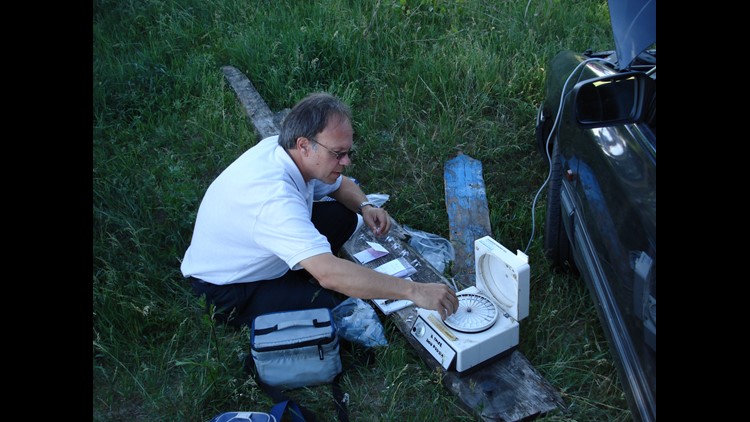![chernobyl_Mousseau [image : 82970964]](http://www.gannett-cdn.com/media/2016/04/13/USATODAY/USATODAY/635961222858115339-tim.jpg)
Timothy Mousseau is a professor of biological sciences at the University of South Carolina-Columbia. He has published more than 90 scientific papers about the effects of radiation on wildlife with his research partner, Anders Møller of the CNRS, the largest government science agency in France. Mousseau has visited Chernobyl dozens of times. He believes the "traditional radiation community has been slow to acknowledge the ramifications of nuclear accidents for wildlife."
Here are his words, edited and condensed for clarity:
My first visit to Chernobyl was in 1999. One of the first things I noticed was that many of the trees that had been killed during the disaster 15 years prior were lying on the ground still relatively intact. Meanwhile in the forests, there were very few spider webs clinging to our faces as we cut through the brush looking for birds. Birds seemed less numerous than in nearby areas relatively unaffected by the radioactive contaminants.
![Signs of life return [video : 83100982]](http://videos.usatoday.net/Brightcove2/29906170001/2016/04/29906170001_4847530160001_FOX.jpg?pubId=29906170001)
Through a long series of experiments over many years, we learned that this dead organic matter — the trees and leaves — was decomposing at a much slower rate because the radiation was affecting the growth of bacteria, fungi, worms and insects that normally turn wood to sawdust.
![30 years later, Chernobyl's searing legacy still crippling and killing [oembed : 83173366] [oembed : 83173366] [oembed : 83173366] [oembed : 83173366] [oembed : 83173366] [oembed : 83173366]](/Portals/_default/Skins/PrestoLegacy/CommonCss/images/smartembed.png)
We learned that this accumulation of radioactive litter posed a serious threat to surrounding areas in the event of forest fires, which have been increasing in frequency and severity as a result of climate change in the region.
The trees in Chernobyl were also growing more slowly, most likely because of radiation and reduced nutrient cycling. We discovered that the spiders were far less abundant, as were butterflies, dragonflies and grasshoppers. Many species of birds were all but missing.
![635964082206259582-Belarus-Zone9.jpg [image : 83122160]](http://www.gannett-cdn.com/-mm-/5e6be4daf7d70c35b1ff241b831034b5e8e1bb54/c=0-435-2445-2525/local/-/media/2016/04/16/USATODAY/USATODAY/635964082206259582-Belarus-Zone9.jpg)
One winter we decided to determine whether the mammals showed any effects of the radiation by tracking and counting footprints in the snow of the dozen species active this time of the year. It became clear that for the species with relatively small territories, there were significantly fewer animals in the more radioactive areas, although the top predator in the system, the gray wolf, appeared to come and go seemingly unaffected by the radiation. This was an unexpected finding and went against the prevailing wisdom at the time, which was that Chernobyl's plants and animals were thriving because of the lack of human activity, and that by implication, the radiation effects must be low to none.
![Chernobyl: Timeline of a nuclear nightmare [oembed : 83173370] [oembed : 83173370] [oembed : 83173370] [oembed : 83173370] [oembed : 83173370] [oembed : 83173370]](/Portals/_default/Skins/PrestoLegacy/CommonCss/images/smartembed.png)
We discovered that many of the organisms in the region had suffered genetic damage, and as with survivors of the atomic bombs of Hiroshima and Nagasaki, the birds and mammals had cataracts and smaller brains as a direct consequence of exposure to ionizing radiation in the air, water and food. As with some cancer patients undergoing radiation therapy, many of the birds had malformed sperm and in the most radioactive areas, up to 40% of the male birds were completely sterile. Tumors were obvious on some of the birds in areas of high radiation, as were developmental abnormalities in some plants and insects.
![Gannett-cdn [oembed : 83155402] [oembed : 83155402] [oembed : 83155402] [oembed : 83155402] [oembed : 83155402] [oembed : 83155402] [oembed : 83155402] [oembed : 83155402]](/Portals/_default/Skins/PrestoLegacy/CommonCss/images/smartembed.png)
The traditional radiation community has been slow to acknowledge the ramifications of nuclear accidents for wildlife.
As with any science field, it was difficult to prove with 100% certainty that all of the abnormalities we had found were the result of radiation alone. In Chernobyl, there are other contaminants that could also negatively impact plants and animals.
For this reason we repeated many of our studies in Fukushima, Japan, site of a nuclear plant accident after a tsunami in March 2011, and attempted to precisely estimate these doses. We found very similar patterns of declines in abundance and diversity in a manner that is nearly identical to Chernobyl.
![On edge of a human tragedy, Chernobyl also sees wildlife weirdness by USA TODAY News [oembed : 83155344] [oembed : 83155344] [oembed : 83155344] [oembed : 83155344] [oembed : 83155344] [oembed : 83155344] [oembed : 83155344] [oembed : 83155344] [oembed : 83155344] [oembed : 83155344] [oembed : 83155344] [oembed : 83155344]](/Portals/_default/Skins/PrestoLegacy/CommonCss/images/smartembed.png)
![Interactive Graphic [oembed : 83181416] [oembed : 83181416]](/Portals/_default/Skins/PrestoLegacy/CommonCss/images/smartembed.png)



![Chernobyl 30 years later [gallery : 83036164]](http://www.gannett-cdn.com/-mm-/95af056faa4aa06276311e77a316ba924da8535f/c=62-0-2926-2448/local/-/media/2016/04/14/USATODAY/USATODAY/635962404487303175-XXX-Zone-1.JPG)
